Discover the most comprehensive list of keto foods on the Internet. The list you have been looking for since you learned about a keto diet.
Wondering what to eat on a ketogenic diet? Check out the most exhaustive list of keto diet foods together with pictures, nutritional information and eating tips.
Thought there are few food choices on a keto diet? Just take a look at this variety and you will indeed change your mind!
Introduction To Keto Foods
New to a ketogenic diet and unsure what foods to eat? No problem. ABC Keto is all about making your keto diet easy and effortless.
Keto foods are the most delicious and the healthiest foods in the world. You don’t have to limit yourself almost at all on this eating plan, because you can find healthy keto replacements for almost any kind of food you like. As long as you stick to the plan and eat only keto-friendly foods, you will achieve your weight loss, fitness and health goals. It’s that simple!
Keto diet foods are REAL foods that are full of vitamins, micro-elements and other nutrients. They are low in carbs and in most cases high in fat and protein. They have low glycemic index (GI), so they don’t spike insulin at all. What’s more, they are highly satiating and keep you fool for many hours. They are super foods.
In this section you will discover all possible types of keto foods together with valuable tips, nutritional information and pictures. You can read this page from cover to cover (I recommend doing this) or use the below index to navigate to directly to one of the four main sections of this guide.
Keto Food Pyramid
Learn how a proper (keto) food pyramid should look like and don’t
be surprised that it’s the upside-down version of the food pyramid
you have been taught at school. Discover what net carbs are and
how to calculate them. Discover the best sources of fiber.
Keto Shopping List
Learn how your ideal keto shopping list should look like so that
you are healthy and lose weight. Discover all the keto vegetables,
fruits, fats, proteins, drinks, snacks, nuts & seeds, diary and
zero carb foods you can eat without any restriction.
Common Concerns
Even though keto diet rules are rather simple and clear, people
have diverse opinions about certain products or product types
like supplements, sweeteners, sugar alcohols or alcohol. Bonus
topics include: cheating, eating out and fast foods on keto.
Selected Keto Foods
Discover the list of the most popular products people ask about
in the context of a keto diet. Check the carb quantity of each
product and its “keto compliance”. Example products include diet
drinks, chocolate, honey, grapefruits, and more.
Keto Food Pyramid… The Upside-Down Version Of Traditional Food Pyramid
If you are short for time, you may want to start from studying the keto food pyramid. You may be surprised to see that this is the “upside-down” version of a traditional food pyramid you were taught back in school.
I can assure you that this is the one and only food pyramid you should be following if you care about your health, weight loss or sports performance.
This is the keto food pyramid I’ve designed especially for you. Feel free to print it out and stick it on your fridge.
[KETO FOOD PYRAMID]
Check out the complete keto food pyramid guide with further explanations, extra tips and additional nutritional information about keto foods.
Net Carbs (And How To Calculate Them)
To avoid making the most common mistakes on a keto diet, you need to understand what net carbs are. You will be hearing a lot about net carbs on your keto journey!
Since a ketogenic diet is all about restricting carbohydrates, people use the amount of net carbs to judge whether a given product is keto-compliant or not. Net carbs are simply total carbs minus indigestible fiber. For example, an avocado has 9 g of total carbs. However, 7 g of these carbs is fiber, so avocado net carbs are only 2 g.
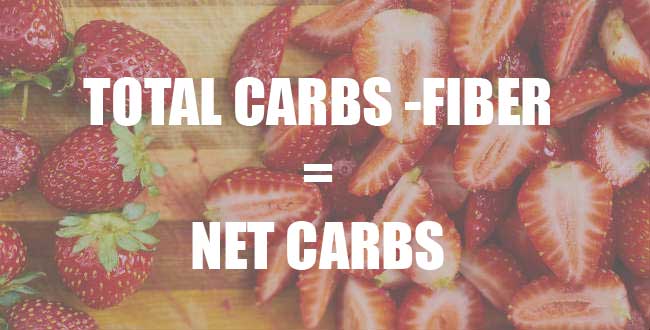
This is the only formula you need to calculate net carbs of any product.
Make sure to check out the guide about net carbs, how to calculate them and how to correctly interpret food labels.
Fiber (Your Best Keto Friend)
Fiber (also called roughage) is an indigestible nutrient that comes from plants. Even though you don’t digest fiber, you still need a lot of it to help food move efficiently through your body. If you ever get constipated on a keto diet, the chances are you are eating too little fiber. Fortunately, many keto-friendly foods are also rich in fiber.
Fiber is what you subtract from a total amount of carbs in a given product to calculate its net carbs. Since fiber is indigestible, you don’t need to count it against your daily carb intake. The example foods very rich in fiber (which are almost all or mostly made of fiber) include:
- Flax seeds
- Chia seeds
- Mustard greens, chicory, endive
- Avocados
- Spinach, broccoli, cauliflower
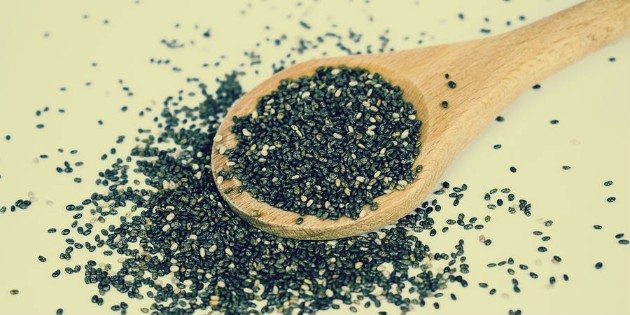
Chia seeds are extremely rich in fiber.
Make sure to read the whole guide on how to get fiber on a keto diet and discover its best sources (a special cheat sheet I have prepared for you). And take a look at the tutorial of how to calculate net carbs.
Keto Shopping List… To Make Shopping Quick & Easy
Shopping on a keto diet doesn’t have to be difficult or overwhelming. You can buy most of the foods only twice a month and make the whole process really simple and quick. Remember that on a keto diet you control food, hunger, time and money. They don’t control you.
You can order many basic keto-friendly products (like stevia, coconut oil, nuts or seeds) over the Internet without leaving your home (via Amazon Grocery & Gourmet Food Department, for example). The only products you will be shopping for more often (probably once or twice a week) include veggies, meat, fish, fruits, dairy or other fresh products.
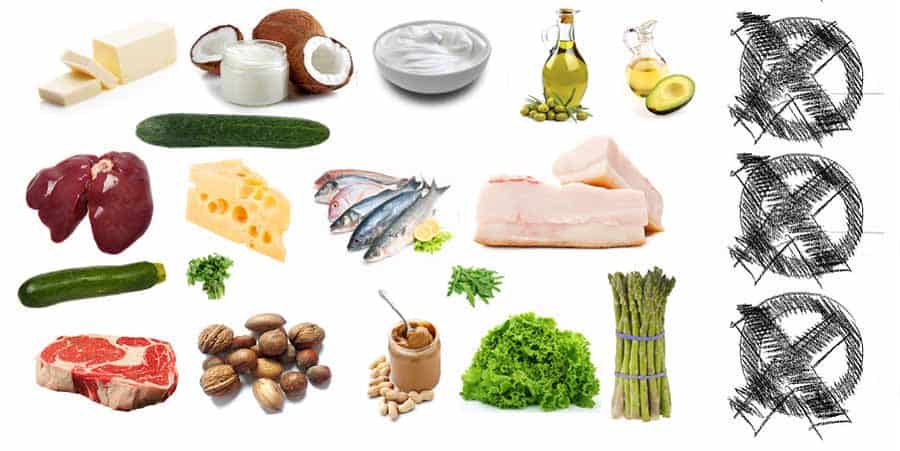
This is how your keto shopping list will look like.
Check out my example keto shopping list with further shopping tips, recommended timing and more. Feel free to adjust it to your needs or share it with others.
Vegetables (Your Carbs)
I am starting the keto food list from keto vegetables because they are the most important foods on a ketogenic diet. Vegetables should be your main source of carbs and fiber. They also provide you with all the necessary vitamins, minerals and microelements.
The basic vegetables to eat on a ketogenic diet include (from the lowest in net carbs): avocado (2), lettuce (1.6), spinach (1.4), asparagus (1.8), cucumber (3), olives (2), eggplant (3), broccoli (4.4), cabbage (3.5), swiss chard (2), cauliflower (3), kale (5), brussels sprouts (5), watercress (0.8), tomato (2.7), green beans (4.3), zucchini (2), arugula (2), mushroom (2), celery (1.4), leek (12), carrots (7.2), pepper (3), onion (7), garlic (30), pumpkin (6.5), peas (9), ginger (16), celeriac (7), turnip (4), fennel (4), jalapeno pepper (4.2), radish (1.8), kohlrabi (2.4), sauerkraut (1.4), bamboo shoots (2.8), okra (3.8), summer squash (2.3) and more.
This is the visual cheat sheet of what vegetables you can eat on a keto diet.
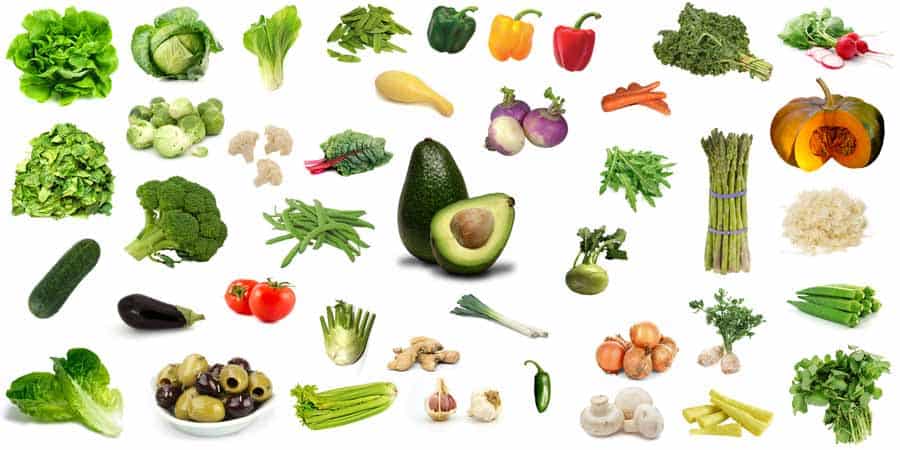
These are the top keto vegetables.
Check out the full list of keto vegetables together with detailed information about carbs and other nutritional facts or view the blog category with different keto vegetables.
Fruits (You Can Still Eat Some)
Even though a keto diet is based mainly on vegetables, you can, of course, eat some fruits. They are also rich in fiber, vitamins and minerals. The rule of thumb is to eat them in moderation and choose the low-carb and low-sugar options. That’s because fruits contain fructose which we try to avoid as much as possible.
Some of the fruits you can eat on a keto diet include (from the lowest in carbs): avocado (2), raspberries (5), strawberries (5.5), berries (11), blueberries (12), kiwi (11), lemon (6.2), cherries (11), cantaloupe (7), watermelon (7), apple (11.5), pear (12), mango (13), banana (20), clementine (10), peach (8), cranberry (8), starfruit (4), plum (7), apricot (9), grapes (16), pineapple (11), lime (8), orange (9.5), grapefruit (9.5), honeydew melon (8), coconut meat (6) and more.
Unsure what other fruits to eat on a keto diet? Take a look at this keto-fruit cheat sheet I’ve prepared for you.
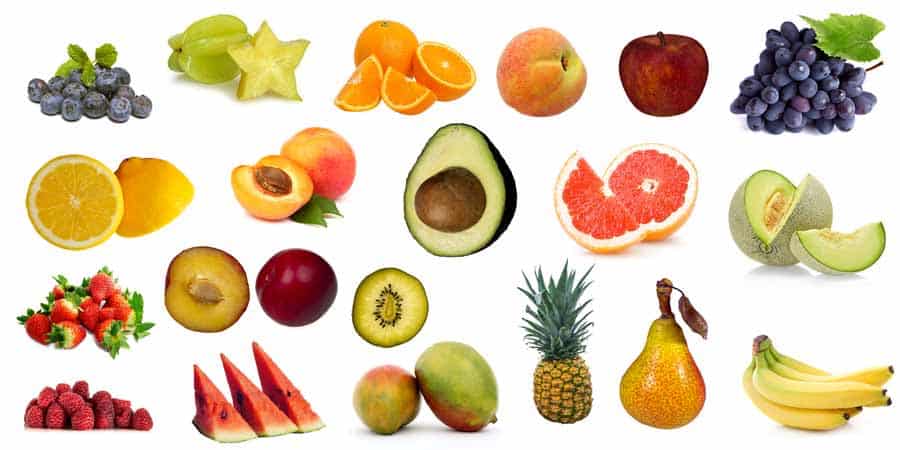
These are the fruits you will be (occasionally) eating on a keto diet. Make sure to always count them against your daily carb intake.
Check out the full guide to keto diet fruits. Click on the picture to view the full list of keto fruits together with detailed information about carb quantity and other nutritional facts or view the blog category with keto fruits.
Fat (Your Absolute Best Friend)
A keto diet is often called a fat or a high-fat diet because 60-85% of energy comes from calories from fat. Exactly how much fat you need on this diet depends on many different factors like your goals (weight loss, gain or maintenance), age, sex, activity level and more.
Read the guide on keto macros to find out your perfect macros that will help you achieve all your keto goals.
Fat is the main source of energy on a ketogenic diet. However, if weight loss is your main goal, I recommend not going overboard with fat and counting how much of it you eat. You’d better be burning your body fat for fuel instead of fat you are eating.
The most important keto fats to consume every day include: butter, coconut oil, olive oil, MCT oil, lard, tallow, macadamia oil, products rich in healthy fats like fatty meat and fish, full-fat dairy products, nuts, seeds, nut butters, egg yolks, avocados and more. Take a look at the cheat sheet with keto fats and products rich in fat.
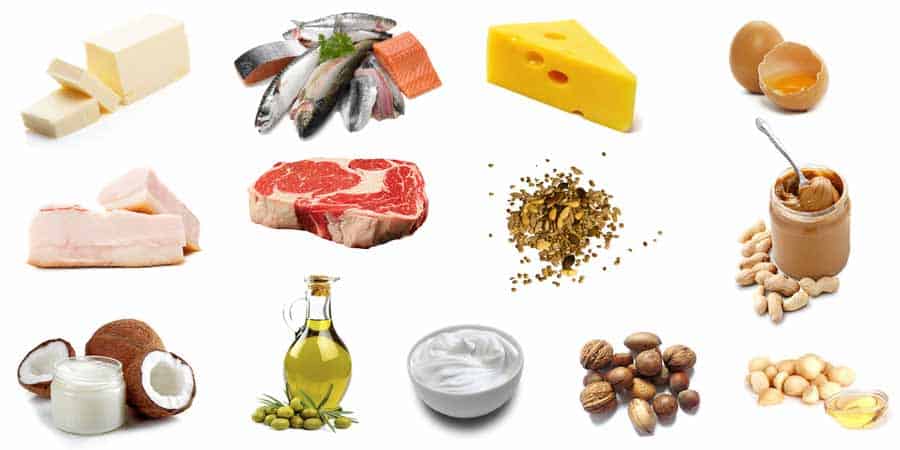
These are the best sources on fat on a ketogenic diet.
Check the full guide with even more examples of keto fats and keto-friendly products rich in healthy fats or view the blog category with keto-approved fats.
Protein Sources (And Fat Sources As Well)
Protein is the second most important macronutrient on a ketogenic diet. About 15-25% of energy comes from calories from protein on this plan. Note that your protein needs depend on many different variables, such as, your goals (weight loss, gain or maintenance), age, sex, activity level and more.
Read the guide on keto macros to find out your perfect macros that will help you achieve all your keto goals.
Protein is an essential macronutrient on a keto diet but you still need to be careful with it. If consumed excessively or in the lean form, protein can disrupt or even stop ketosis. It’s not very difficult to meet protein needs on a keto diet as most of the fatty keto foods contain a lot of protein as well.
The best keto protein sources include (from those with zero carbs to some): meat (beef, pork, poultry), organ meat (especially liver), cold meats (beware of hidden carbs in them), fish (cod, flounder, halibut, trout, salmon, tuna, sardines, mackerel), seafood, eggs, tofu, cheese, mozzarella, cottage cheese, curd, peanut butter (and other nut butters), Greek yogurt, protein powders, and more.
Top tips on selecting the best keto protein sources:
- Always choose fatty meat or fish over the lean alternatives.
- If possible, look for organic, wild-caught and free-range options.
- If you prefer leaner sources of protein like poultry, always add some extra fat to it (at least 30 g). You can add butter, coconut oil or even peanut butter.
- Beware of hidden carbs in some types of cheese, cold meats or nut butters. Always read the nutrition label.
Take a look at your keto protein cheat sheet to avoid common mistakes with eating protein on a keto diet.

These are the top protein sources on a keto diet.
Check out the full list of the best protein sources with extra tips, illustrations and information. You can also view the blog category with shorter articles describing different protein sources on keto.
Drinks (You Can Have Freely)
Even though keto is a “all-or-nothing” type of diet, it doesn’t mean that you can only drink water and unsweetened tea. Once you get a little creative (and make use of some keto drink recipes), the spectrum of your keto-approved drinks will become really wide.
Some example keto drinks include: coffee (black, with cream or keto/bulletproof coffee), Yerba Mate, fruit-flavored tea (as long as it doesn’t contain sugar or candied fruits), coconut milk, almond milk (and other milk alternatives), water with mint and lemon, dry wine, champagne and more.
Note that some of these drinks are not zero carb. However, you can drink all of them as long as you count them against your daily carb intake and drink them in moderation (especially alcohol). Feel free to add natural sweeteners (Stevia or erythritol) to your coffee or tea, but don’t go overboard.
This is your cheat sheet showing the best keto drinks.
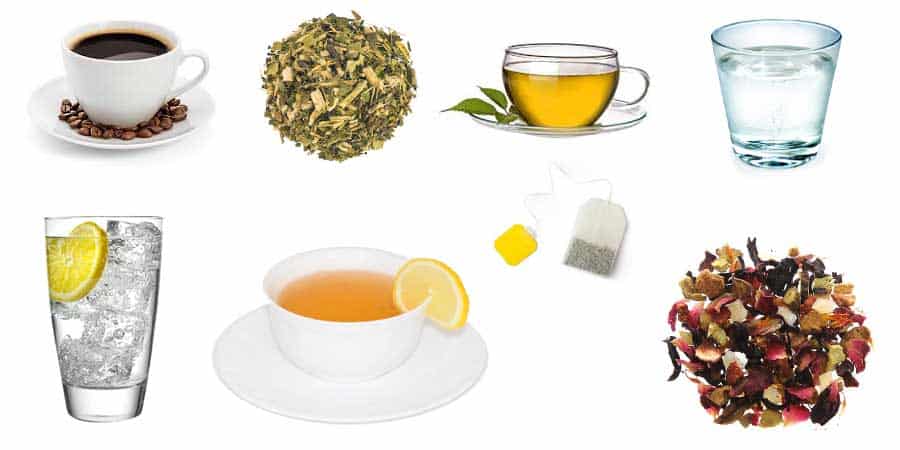
You can drink these drinks on a keto diet without any limitations as long as you don’t put sugar into them.
Read the full guide to discover more examples of keto drinks or browse keto drink recipes if you want to have a keto drink right now. You can also view the whole blog category with shorter articles and recipes for keto drinks. Take a look at the intermittent fasting drinks guide to discover even more examples.
Snacks (That Are Keto-Friendly)
Once you get into ketosis, your appetite for snacks will probably disappear. However, before you get there, I want to show you some of the best keto snacks.
Examples of simple snacks you can have on a keto diet include: nuts, a few cubes of sugar-free chocolate, baked-kale chips, a few olives, a spoonful of nut butter, one boiled egg, a tablespoon of butter/flavored coconut oil and more.
Take a look at the visual cheat sheet of what other simple snacks you can have on a keto diet. I did my best to include only really low-carb options.

These are the top keto snacks that will kill any cravings should you have them.
Check out the whole guide on keto snacks together with detailed information about carbs and other nutrition facts. You may also want to browse keto snack recipes to discover more options.
Zero Carb Keto Foods (Absolute Keto Winners)
Did you know that there indeed exist zero carb foods? Many of the keto foods have zero or almost zero carbs. If you are following a standard ketogenic diet (with less than 20 grams of carbs a day), these zero carb foods should become your bread (well, not literally) and butter.
Some example zero carb foods include: meat, fish, fats (like butter, olive oil, coconut oil), seafood, some milk alternatives (some almond milks are below 0.1 g of carbs), spices, zero pastas, natural sweeteners (Stevia, erythritol) and more.
Take a look at the cheat sheet to zero carb keto foods which you can eat rather freely on a keto diet.
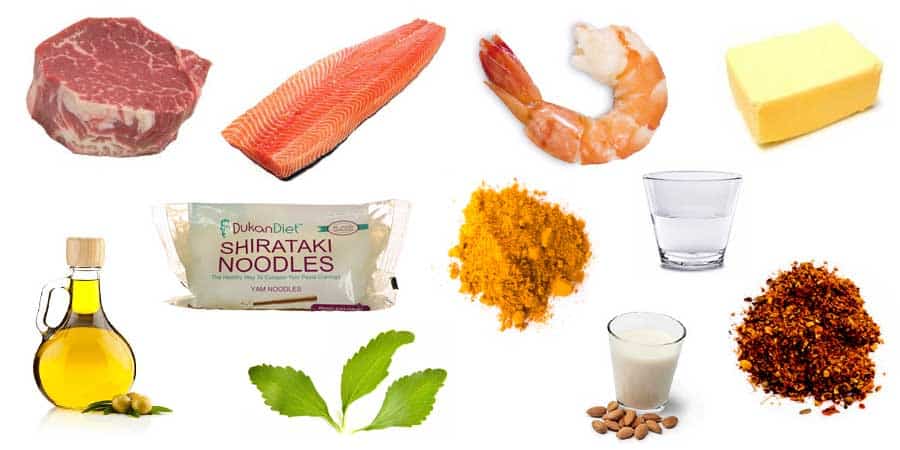
A few examples of zero or almost zero-carb foods you can have on a keto diet.
Check out the complete list of the best zero carb foods together with pictures and important nutrition information.
 Common Product Concerns On Keto… Don’t Miss This
Common Product Concerns On Keto… Don’t Miss This
While it’s obvious that some foods are 100% keto-friendly (just take a look at the logo of ABC Keto), people have divided opinions about others.
Some say you can eat anything on a keto diet as long as it doesn’t have carbs or calories (i.e. diet drinks or hard liquors). Others say that most of these products (even though they have no carbs) will still disrupt ketosis and stop fat burning.
Who should you listen to? Who is right? Check out my very common-sense take on it and decide for yourself.
Supplements (Top Three You Probably Need)
Are you wondering what supplements you should take on a keto diet? Not sure if taking any supplements on a keto diet is a good idea?
Well, it all depends on your context (age, fitness level, goals) and, above all, your current health. What’s more if you eat a lot of vegetables (and you should), you can probably take fewer supplements and only the necessary ones.
Here are the supplements almost everyone has to take on a keto diet:

Remember that you usually need different supplements on a keto diet than on a standard American diet.
Check out the full guide to keto supplements to learn which supplements you need or view the blog category with shorter articles about specific keto diet supplements.
Fast Food (Not What You Think)
Are fast foods an absolute NO on a keto diet? Unfortunately, fast foods aren’t allowed on a keto diet because they are usually very rich in carbs and fat (and this is a deadly combination).
However, there are a lot of ways in which you can make fast foods keto friendly. You can also prepare your own keto fast foods which will look and taste just like regular fast foods but will contain little or no carbs.
Here are the top tips regarding fast foods and a keto diet:
- If you order fast food at a restaurant, make sure not to order buns. If you are ordering a burger, trade its bun for an extra amount of salad or butter and you are good to go.
- You can also bake you own keto buns (click to view the recipe) and prepare the most delicious keto burgers (click to view the recipe) in the world. All you need to do is replace wheat flour with coconut or almond flour and your burgers will be low-carb.

You can easily make fast foods keto-friendly and consume them on this eating program.
Check out the full guide to eating fast food on keto or get inspired and learn how to prepare keto friendly fast food meals.
Dairy (Good News)
Dairy, whether on a keto diet or not, is a bit controversial subject. Milk, for example, is relatively high in carbs (sugar called lactose) and many people get bloated after consuming too much of it (many are also lactose-intolerant).
On the other hand, most people simply like how dairy tastes. Fortunately, it is not corn and we can consume it in moderation on a keto diet. The most important thing to remember is to use full-fat dairy products, count them against your daily calorie intake and always read the label.
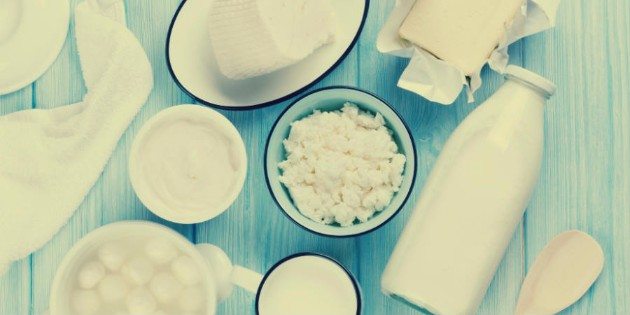
You should eat only full-fat dairy on a keto diet.
Not sure which dairy products to eat or avoid? Check out the full guide to eating diary on a keto diet or learn more about milk on a keto diet.
Sweeteners (Ugly Truth)
Sweeteners on a low-carb or zero-carb diets are another a bit controversial topic and there are really two main schools of thought.
One says you can use sweeteners as they have no caloric value and don’t cause insulin spikes. The other one claims they are very unhealthy, effectively “sustain” your carb addiction and may even cause “instinctive” insulin spikes.
ABC Keto says you should use them in moderation and use only natural sweeteners like stevia (preferably in the liquid form) and erythritol. Avoid artificial sweeteners at all costs.
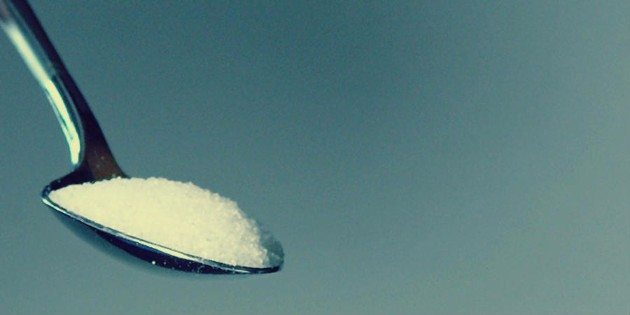
You should only use natural sweeteners.
Read the full guide on the keto sweeteners or view the blog category with shorter articles about different keto diet sweeteners.
Sugar Alcohols (And Whether They Are OK Or Not)
Are sugar alcohols OK on a keto diet? Or should you avoid them? Unfortunately, people also have diverse opinions on sugar alcohols in the context of a keto diet.
Some say most sugar alcohols (like Stevia or erythritol) are totally OK because they have the zero GI (glycemic index), so they don’t spike insulin. Others say that anything that tastes sweet (whether it has sugar or not) will cause some insulin spike, stop fat burning and disturb ketosis.
The ABC Keto top advice on sugar alcohols consumed on a keto diet is as follows:
- Use them in moderation and save them for you keto cheat meal cake (instead of using sugar).
- Make sure not to overeat them because you will have digestive problems (like diarrhea).
- If you want your keto coffee to be sweet, try not to add them to your coffee more often than once a day.

Sugar alcohols are technically OK but it’s best to use them in moderation.
Check out the full guide to sugar alcohols in the context of a keto diet.
Alcohol (Dos & Don’ts)
A keto diet is a rather strict diet that doesn’t allow many exceptions or cheat meals (not to mention cheat days). Even so, you can still drink small portions of some types of alcohol without reversing your progress.
The types of alcohol you can drink on a keto diet include: dry wine, champagne, hard liquors (like vodka, whiskey, rum) or small amounts of low-carb beers. Take a look at the cheat sheet with the allowed types of alcohol on a keto diet.

These are the allowed types of alcohol.
Alcohol is a controversial issue on a keto diet because drinking even a small amount of a forbidden beverage can kick you out of ketosis and stop your progress. Whenever you drink alcohol, your liver starts to prioritize it over other foods which will most likely be stored as fat. What’s more, if you are under influence, you are more likely to binge on carbs and other non-keto foods.
This is the cheat sheet with forbidden types of alcohol you want to avoid at all costs.
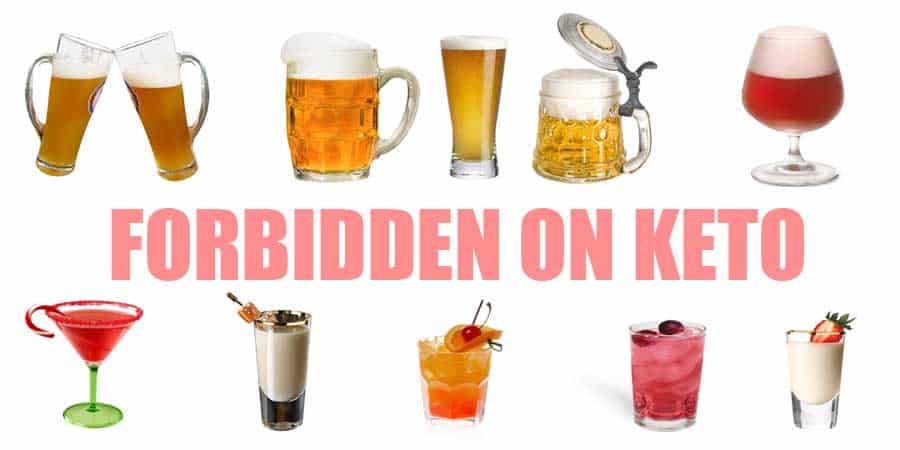
You should avoid these types of alcohol beverages on a keto diet.
Drinking alcohol can have absolutely no negative impact on your keto progress and weight loss as long as you do it right (i.e. drink only allowed types and don’t combine drinking with eating).
Mare sure to check out my guide on drinking alcohol on keto so that you don’t hinder your progress or gain weight.
Nuts & Seeds (Your Best Friends)
Nus are allowed or even recommended on a keto diet. They are rich in healthy fats, fiber and protein. Most of them don’t have very many carbs (Brazil, macadamia, pecan) but you need to be careful with some (especially cashew).
The rule of thumb here is to eat nuts but consume them in moderation and always count them against your daily carb intake.
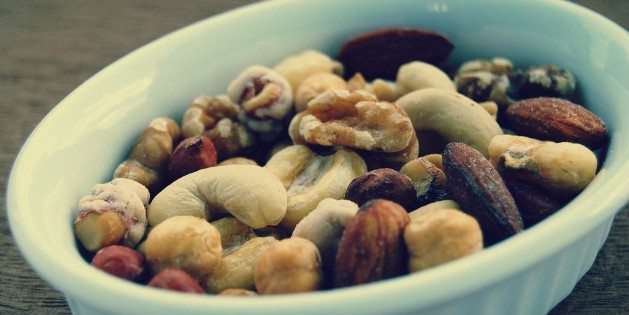
Nuts are a great source of fat and protein. However, you need to be careful with their carb amounts.
Read the full guide to best keto nuts and seeds to discover carb amounts of specific types and other important nutrition facts. You can also view the keto diet nuts and seeds blog category to browse all the articles from it.
Eating Out On Keto (You Can Do It)
Staying on track with your diet is easy as long as you are following your daily routine and preparing your keto-friendly meals yourself. The problems usually begin when you go out with your non-keto friends.
Luckily, it’s possible to eat out on a keto diet without getting off track. There is just a bunch of rules you need to remember about and you should be fine both doing keto and eating out. I will be happy to share these tips with you.
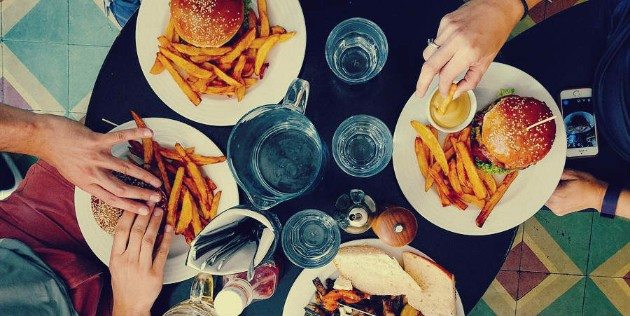
Eating out on keto doesn’t have to look like this.
Read the ultimate guide on eating out on a ketogenic diet so that you can both enjoy your life and stay on track with your diet.
Cheating (Tips & Good News)
Even though cheat days on a ketogenic diet can completely stop or even reverse your progress, we all know that we sometimes just have to cheat. They key is to know how to cheat and to do it wisely. If you do it right, you minimize the negative effects of getting off the plan and even get an additional boost in motivation.
Here are a few top tips on cheating on a keto diet:
- Make sure to cheat with keto cakes that contain erythritol or Stevia instead of sugar. You will do yourself no harm cheating with keto desserts. In the worst scenario you will only go over your daily caloric needs, which isn’t a very big deal on a keto diet (if you don’t do it every day).
- Plan your cheat meal for the evening so that you can start over the next day and shorten the number of extra calories or bad foods you consume. If you start in the morning, you are likely to have a cheat day instead of a cheat meal.
- If you plan to cheat on carbs, cut fat for this day or it will be directly stored in your body. It’s extremely unhealthy to combine carbs with fats.
- Don’t combine huge carb cheat meals with drinking alcohol. Do either one or the other and you will store much less fat and get back to ketosis quicker.

Cheating on a keto diet can be both delicious and healthy.
Check out the ultimate guide to cheating on a keto diet to learn how to plan a perfect keto cheat day that is both delicious and compliant with your long-term goals.
List Of Selected Ketogenic Diet Foods… And Essential Facts To Know About Each One

Below each type of food you can find some basic information about its “keto compliance”, some nutrition facts, a reference photo and a link to a more in-depth guide. You can use the below index to directly navigate to the type of food you are interested in if you don’t have time to study the whole page.
For most keto diet foods described below I am giving you their net carb quantity and sometimes other important nutritional facts. All of these values are per 100 g (3.5 oz).
Check out the full ketogenic diet food list with carb amounts for each product.
Coffee (Must-Have)
Net Carbs: From 0 up to 30 g depending on the typeYes, you can and you even should drink coffee on a ketogenic diet. Not only is it healthy but it can also become your favorite “meal” or “cake of the day”. However, if you are new to a keto diet and trying to get into ketosis, you may want to be careful with types and amounts of coffee you drink.
Coffee is high in caffeine which in large quantities may disrupt ketosis and cause an insulin spike. Don’t drink more than 2-3 cups of coffee a day. Beware of types of coffee served at restaurants and in bars. These coffee types are usually full of carbs and sugar.

Coffee addicts can drink their favorite beverage on a keto diet.
Feeling confused? Check out my full keto coffee guide. You can also browse keto coffee recipes if you’d rather have coffee now (not read about it).
Diet Soda (You Decide)
Net Carbs: 0Whether diet soda or other types of diet or zero drinks are OK on a keto diet is another controversial issue. They are “technically” OK because they are usually have no calories. However, they are often full of artificial sweeteners like aspartame or sodium cyclamate.
When evaluating any piece of food or type of liquid we are about to put into our stomach, we should analyze it both in terms of carbs and its nutritional value. A piece of food or a drink is keto-friendly only if it has few carbs and is nutritious. Do diet drinks meet these criteria? Nope.
That’s why the advice here is to avoid diet soda or drink it once in a blue moon (if you really need to).

Diet soda is keto friendly but not entirely healthy.
Check out my full guide on drinking diet soda on a keto diet with further tips, recommendations and other possible healthy alternatives.
Diet Coke (You Decide)
Net Carbs: 0Diet Coke is probably the most popular sugar-free drink in the world. Unfortunately, it does contain aspartame, which makes it not the healthiest option. That’s why I would advise drinking a Diet Coke only occasionally when there are really no other options.
It surely is better than a regular Coke (with 8 tablespoons of sugar) but it’s still not a healthy or recommended option.

You should drink Diet Coke only occasionally.
Learn more about Diet Coke a keto diet to decide if it’s OK for you.
Milk (Yes & No)
Net Carbs: 5You can drink very little amounts of milk on a keto diet but the general rule is to avoid it. Milk is high in lactose (sugar milk) which likes to bloat your stomach and spike insulin. One big mug of milk can kick you out of ketosis and stop your progress. That’s why, you need to be really careful with milk.
Fortunately, there are really many great alternatives like almond milk or coconut milk. Once you get used to them, you will never want to get back to regular milk. Believe me (I used to be a milk addict).
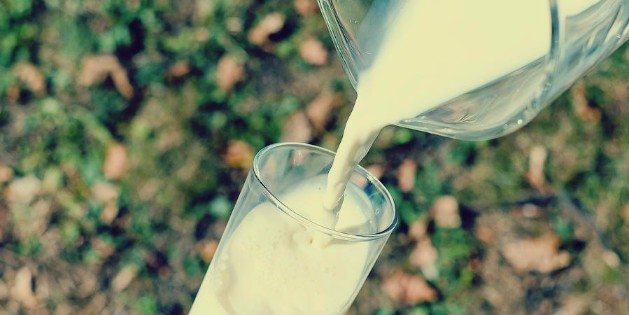
You need to be very careful with drinking milk on a keto diet.
Check out my guide on drinking milk on a keto diet to learn about its nutritional value and how keto-friendly it really is.
Peanut Butter (One Of Top Keto Foods)
Net Carbs: from 4 g up to 25 gIf you like peanut butter, you are going to love this eating plan. Peanut butter is a great source of both good fat and protein. What’s more, the protein-to-fat ratio in peanut butter is very good and keto-friendly.
There are, of course, different types of peanut butters with different carb quantities. Some have as much as 25 g of carbs while others have only 4 or less. Aim for the lowest in carbs!

Peanut butter is a great source of protein and fat on a keto diet.
Fan of peanut butter? Check out my guide to eating peanut butter on a keto diet to avoid common mistakes.
Honey (Not Really Keto-Friendly)
Net Carbs: 82 gHoney, even though it comes from nature, is sugar and you need to be very careful with it on a keto diet. It has 82 g of carbs, so you must always count it against your daily carb intake. Also make sure to consume it only occasionally (not every day).
However, it is metabolized differently and has a bit lower glycemic index (60) than regular sugar (70). It also has other good qualities so it’s not forbidden as long as you eat it in moderation and in small amounts.
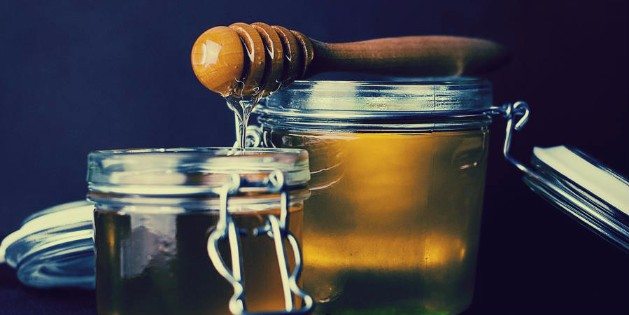
Even though honey is sugar you can have some of it on a keto diet.
Are you a fan of honey? Check out my ultimate guide to eating honey on a keto diet.
Chocolate (Is OK If It Has No Sugar)
Net Carbs: from 10 g up to 60 gGoing on a keto diet and giving up sugar entirely doesn’t mean that you will not be able to eat chocolate. All you need to do is make sure to eat sugar-free chocolate sweetened with natural sweeteners or prepare your own keto-compliant chocolate.
The rule of thumb with chocolate is that it cannot have any added sugar and if it contains sugar alcohols they should be below 20 g. If you decide to eat the whole bar of sugar-free chocolate (which may have up to 30-40 g of alcohol sugars), make sure to count half of its carb amount against your daily carb intake.

You can eat chocolate as long as it has no sugar.
Read the full guide on how to eat chocolate on a keto diet without getting kicked out of ketosis.
Dark Chocolate (Watch The Carbs)
Net Carbs: from 10 g up to 60 gSome keto plans let you eat dark chocolate and that’s OK. However, you need to remember that very often dark chocolate has the same amount milk chocolate has and the only difference is that it has more cacao powder.
That’s why you need to be very careful with eating dark chocolate on a keto diet. If you are unsure of its sugar content, eat just one cube (not the whole bar). If you really feel like eating more than one or two cubes, make sure it’s sugar-free dark chocolate that’s sweetened with erythritol or Stevia. Beware of maltitol which spikes insulin almost as much as pure sugar.

Be careful with dark chocolate and always check its carb and sugar quantity.
Read the full guide on eating chocolate on a keto diet.
Cheese (Both Fat & Protein)
Net Carbs: 0-2 gCheese is probably one of the most popular keto foods that appear in most keto visual guides. This is a great source of protein, fat and, among others, calcium. You should definitely eat cheese on a ketogenic diet!
However, some types of cheese do have some carbs (and some even have added sugar), so you may want to be careful and always read the label when shopping for cheese. You can eat cheese with vegetables, fry it or eat its smaller portions as snacks.
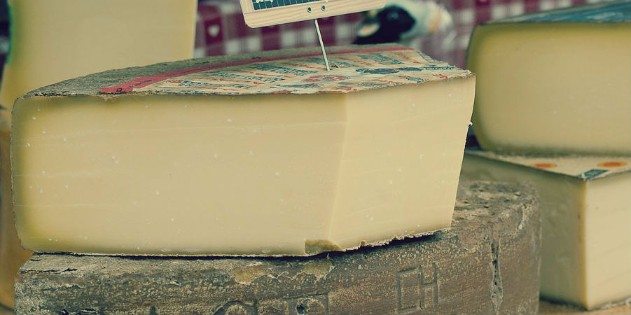
You can eat cheese on a keto diet.
Not sure whether to eat or not to eat cheese? Check out my full guide on eating cheese on a keto diet and discover the most keto-friendly types of cheese.
Yogurt (Not Really)
Net Carbs: from 4 g up to 30 gI generally don’t advise eating yogurt on this eating plan except for Greek yogurt. Yogurt is usually high in carbs (it may even have above 25 g if there is added sugar in it) and low in fat, which makes it not keto-compliant.
It’s OK to add a little bit of unsweetened yogurt (like a spoonful) to your salad or dessert. However, I don’t recommend making yogurt the main ingredient of a meal because it’s low in fat and protein which should be your two main macro-nutrients on a keto diet.
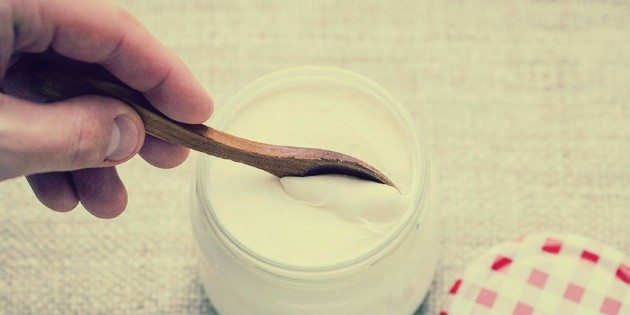
You need to be careful with eating yogurt because it often has lots of hidden carbs.
You can learn more about eating yogurt on a keto diet in the special guide with example products, more nutritional facts and extra eating tips.
Greek Yogurt (The Only Recommended Type Of Yogurt)
Net Carbs: 3 gGreek yogurt is a great alternative to regular yogurt on a keto diet. It is low in carbs (3 g) and usually has a decent amount of protein (10 g), which makes it a good keto product. This is one of the few keto-compliant diary products.
Moreover, Greek yogurt is also the main ingredient of many popular keto desserts you will soon discover. When shopping for this product, make sure to read the label and always choose the fatter version.
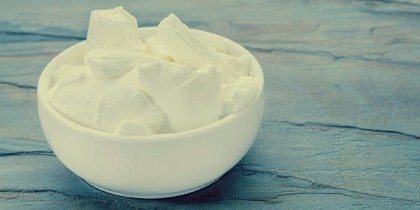
Greek yogurt is a great alternative to regular yogurt.
You can learn more about eating Greek yogurt in the special guide with example products, more nutritional facts and extra eating tips.
Cottage Cheese (Dairy Can Be Good)
Net Carbs: 2-3 gCottage cheese is one of the most popular products on many weight-loss programs. Not only is it rich in protein (about 10 g) but it usually has few carbs (2 g) and has some fat (5-7 g). If you like cottage cheese, feel free to eat it but don’t go overboard because it has some lactose (it’s usually 4 g per one standard serving).
If you want to create a perfect and highly nutritious keto meal, I suggest you blend cottage cheese with some peanut butter. You can also add cocoa powder for better taste and I bet you are going to love it.
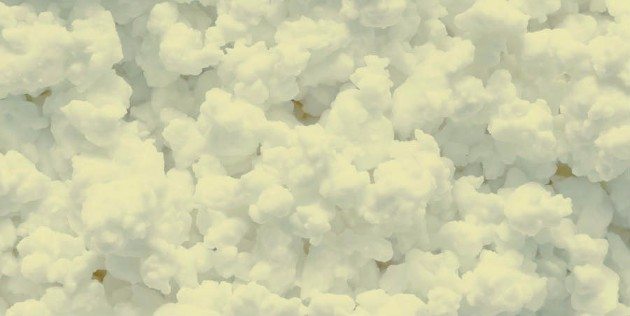
Cottage cheese is very OK on a keto diet.
You can learn more about eating cottage cheese on a ketogenic diet in this special guide.
Peanuts (Not As Tasty As Peanut Butter But…)
Net Carbs: 7 gPeanuts are probably the most popular type of nuts. Most nut butters are made from peanuts. Who hasn’t eaten or doesn’t like peanut butter? I guess no one! Fortunately, you can eat peanuts and peanut butter on a keto diet as long as you consume them in moderation.
You need to be very careful with the amount of peanuts, other nuts and nut butters you consume. The problem is that once you start eating them it’s very hard to stop. The extra calories and fat you consume from nuts can very quickly add up and even kick you out of ketosis and cause digestive problems.
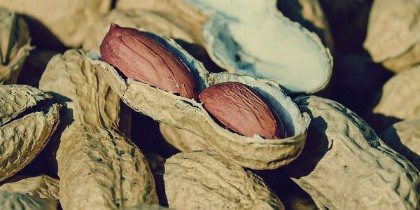
Both peanuts and peanut butter are OK on a keto diet.
A fan of peanuts? Check my guide to eating peanuts to learn more about their nutritional value and how to consume them on this program.
Almonds (Great Choice)
Net Carbs: 10 gEven though almonds are a bit higher in carbs, you shouldn’t avoid them on a keto diet. They are very rich in fiber (12 g), so you can easily add a couple of them to your salad every day or just edd them as snacks.
I also recommend drinking almond milk (which is very low in calories and net carbs) as an alternative to regular milk. Talking about almonds, almond butters and almost flour are also great choices but I will tell you more about them on another occasion. I swear.
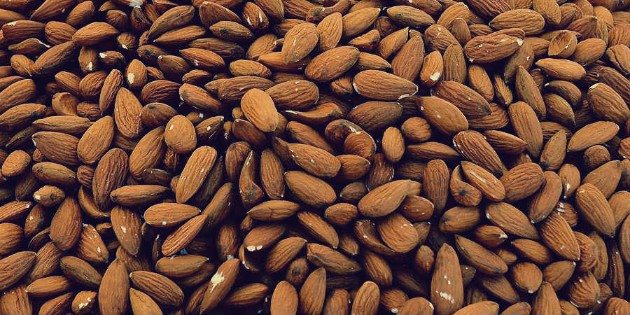
You should definitely eat almonds on a keto diet.
Read the full guide with more information on eating almonds on a keto diet and learn more about their nutritional value.
Chia seeds (Top Keto Seed)
Net Carbs: 2Chia seeds are one of the top keto foods for me and really love them. I bet you are going to love them too once I tell you a bit more about this super food. Chia seeds are ideal for preparing delicious low-carbs pudding desserts or shakes.
With only 50 g of chia seeds flooded with hot water and a bit of coconut milk, you can create a really huge and tasty dessert (that has almost zero carbs net). Add a bit of Stevia, strawberries and coca powder and any sugar cravings will be gone for good.
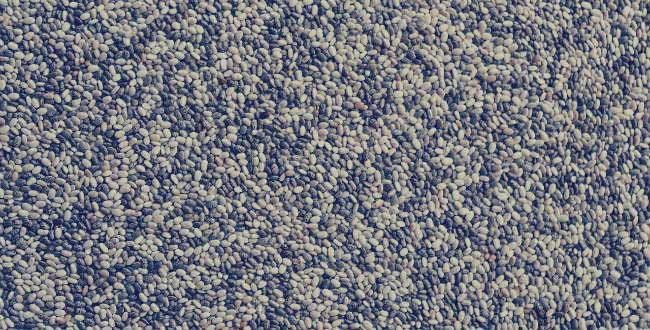
Chia seeds should become the essential part of your keto diet.
Learn more about chia seeds, their nutritional value and discover more chia keto meals in the special guide to chia seeds on keto.
Sunflower seeds (Good Choice)
Net Carbs: 10 gSunflower seeds are another type of seeds that should become part of your keto diet almost on a daily basis. Like most seeds, sunflower seeds are mainly fat (51 g per), are moderate in protein (21 g) and contain only 10 g of carbs. Such nutritional values make them a perfect keto food.
You can eat a handful of sunflower seeds as a very satiating snack or add them to you salad to make it more tasty. If you have problems hitting your daily fat requirements, a small serving of sunflower seeds will help you do that.

Sunflower seeds have a perfect ratio of fats, protein and carbs for a keto diet.
Discover more nutritional facts about sunflower seeds and why you should eat them on a ketogenic diet.
Pumpkin seeds (Moderation Recommended)
Net Carbs: 24 gPumpkin seeds are another great addition to your keto diet. However, in comparison to most seeds (like sunflower seeds), they are relatively high in carbs (24 g) and low in fat (19 g). That’s why you need to be careful with them and consume them in smaller amounts.
Just make sure to count their carb amount against your daily carb intake and you are going to be fine. They are full of various nutrients like magnesium, zinc or copper so you certainly want to include them in your keto diet. Just be careful and eat them occasionally.
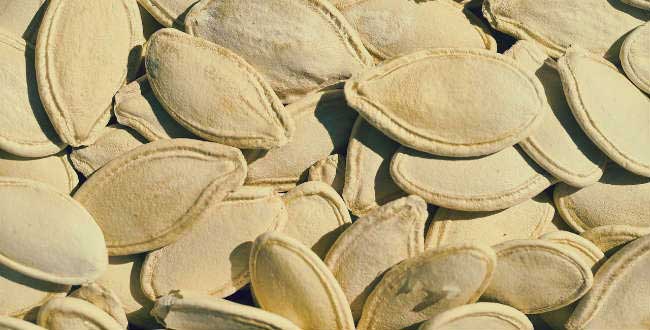
Pumpkin seeds are great on keto in small amounts.
Learn more nutritional facts about pumpkin seeds and how you can eat them on your keto diet.
Hummus (Great But Be Careful With Carbs)
Net Carbs: 8 gHummus is the bread and butter for vegetarians and vegans but people on a ketogenic diet can also make use of this product. If you like the taste of hummus, feel free to add some of it to your meals.
However, be careful because it has about 8 g of carbs net. It’s very easy to eat too much of hummus because it’s quite tasty (especially if it’s flavored with peppers). That’s why, I would suggest only adding just a spoonful of hummus to your salad to improve its taste and hit your daily fat needs more easily.

Hummus is not only good for vegans but also for people on a keto diet.
Learn more about eating hummus on a ketogenic diet in this guide.
Tofu (Great Choice)
Net Carbs: 1-2 gTofu is another vegan and vegetarian type of food that you can eat freely on a keto diet. It has very few carbs (below 2 g), a little fat (5-10 g) and a decent amount of protein (9-12 g). Of course, these nutritional values may differ from one type of tofu to another but overall it’s a good keto food that should be on your weekly shopping list.
It’s a great “protein-base” for many dishes. If you add a good portion of fat to the dish, it will become an almost ideal keto meal. All you need to do is make sure that the tofu you are eating is non-GMO and gluten-free.

You can eat plenty of tofu on a keto diet.
Read more about eating tofu on a keto diet, its nutritional value and possible uses.
Sushi (OK As Long As You Tweak It)
Net Carbs: 15-30 gI have both good and bad news for sushi fans. The bad news is that all the traditional recipes for sushi contain lots of rice which isn’t allowed on a keto diet. Regular sushi may have as much as 30 g of carbs per 100 g and you usually eat a lot more than 100 g (it’s usually 200-400 g per portion at a restaurant).
The good news is that you can use alternative (and equally tasty) cauliflower rice and make keto-friendly sushi. All the ingredients stay the same except for the rice which you replace with cauliflower rice.
The chances are that once you taste the keto sushi you will never want to eat regular sushi any more.

Unfortunately, sushi is not a keto-friendly dish.
View the full guide on keto diet sushi to find more tips, tricks and rice replacements.
Shrimp (Very OK)
Net Carbs: 0.2 gShrimp together with other seafood is allowed on a keto diet. It has a lot of protein (24 g) and almost no carbs. It is rather lean type of protein, so you may want to eat it together with some fat (at least 30 g).
You remember that one of keto rules is to avoid eating lean protein, right? Feel free to add some butter, MCT or coconut oil to it and you are good to go. And, as always, don’t forget about a portion of vegetables to your every meal.

Shrimp is a great source of lean protein.
Feel free to read the full guide with more tips and information about eating shrimp on a keto diet.
Mushrooms (Yes)
Net Carbs: 2 gMushrooms, which are very low in calories and carbs (2 g), are totally OK on a ketogenic diet. You can prepare a lot of delicious dishes or sauces with mushroom and they will almost all be zero in carbs.
You can eat both cooked and fermented mushrooms, add them to your salads or eat them with eggs. There are really lots of ways to eat them on a keto diet and to fall in love with their taste. However, if you like picking up mushrooms, make sure to collect only the edible ones. 🙂

Mushrooms are ideal low-carb addiction to any keto meal.
Read the full guide on eating mushrooms on a keto diet and check what kinds of mushroom are the best on this eating plan.
Potatoes (Rather Not)
Net Carbs: 15 gPotatoes, including sweet potatoes, are unfortunately a kind of foods to avoid on a keto diet. Sweet potatoes have about 17 g of net carbs and regular potatoes about 15 g. This, of course, doesn’t mean that you cannot and will never be able to eat potatoes again.
My best recommendation here is to eat them only on your carb day and on other days replace them with lower-carb alternatives like cauliflower. This way you will not feel deprived and be able to continue your keto journey.
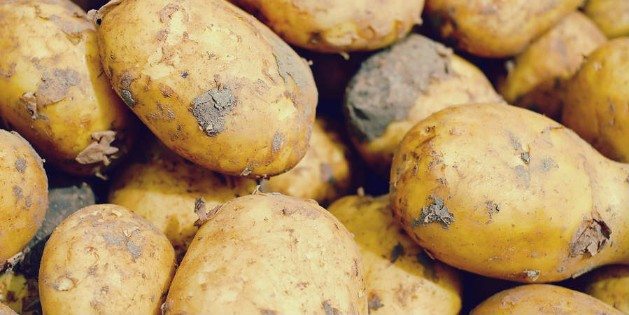
You can only eat potatoes on your carb days.
Check out the full guide to eating potatoes on a ketogenic diet and discover other possible potato alternatives.
Rice (Nope)
Net Carbs: 75 gYou cannot eat rice on this eating plan because rice is one of top high-carb and high GI foods to be avoided on a keto diet. You have probably noticed that you can eat tons of rice and you feel hungry in an hour again.
However, you can easily replace it with many equally tasty alternatives. The two top rice alternatives are cauliflower rice or zero shirataki rice. Both taste even better and have almost no carbs.
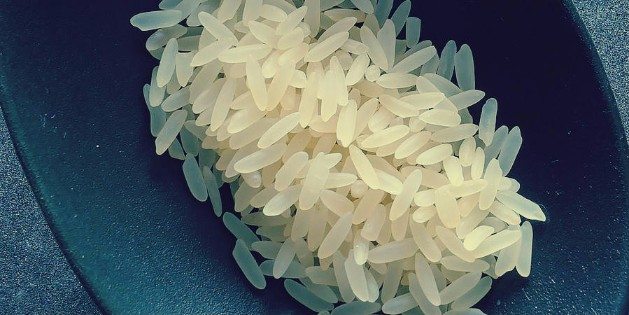
You can have rice only on your carb days on a keto diet.
Read the full guide to eating rice on keto and discover other awesome alternatives.
Grapefruit (A Good Fruit)
Net Carbs: 9 gEven though fruits aren’t highly recommended on a keto diet (especially citrus fruits), grapefruit is an exception. It is a little more high in carbs (9 g) but the combination of juices and properties it has makes a it a keto-compliant fruit.
Of course, I don’t recommend eating it every day (or more than one at a time) but nothing will happen if you eat in once a week after or before an intensive workout. Grapefruits are one of top remorse-free keto fruits and I really love them.
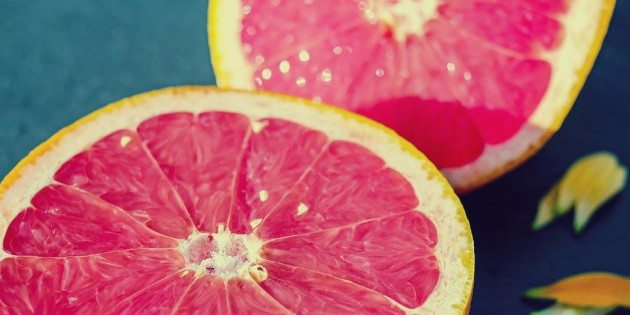
Grapefruit is an exceptional fruit which you can eat on a keto diet.
Learn more about eating grapefruit on keto.
Apples (Bad News)
Net Carbs: 12 gApples are a bit higher in carbs (12 g), so they aren’t really recommended on a keto diet. However, they have a lot of vitamin A and other pro-health benefits, so you might want to eat an apple once in a while.
The best time for eating apples will be your carb-ups, cheat days or times soon before or after an intensive workout. Please just make sure to eat raw apples, never cook them (their glycemic index will skyrocket) and avoid drinking apple juice.
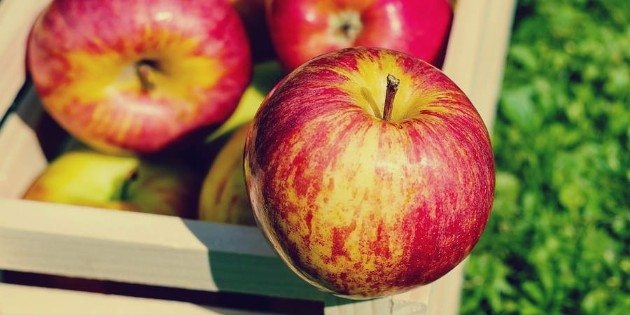
You need to be careful with apples because they are high in sugar.
Read the full guide on eating apples on a ketogenic diet to stay on track with your diet and don’t let fructose spoil your progress.
Olives (Almost As Good As Avocados)
Net Carbs: 0-3 gIf you like olives, you will be happy to hear that you can eat them freely on a ketogenic diet. They have few carbs (below 3 g) and quite a lot of fat (11 g as for vegetables). Olives can be a great supplement to your breakfast, lunch, dinner, or salads. You can use them as snacks too.
Note that black olives are usually even better and have less carbs. Mine have below 1 g of carbs so I don’t really limit myself when eating them.
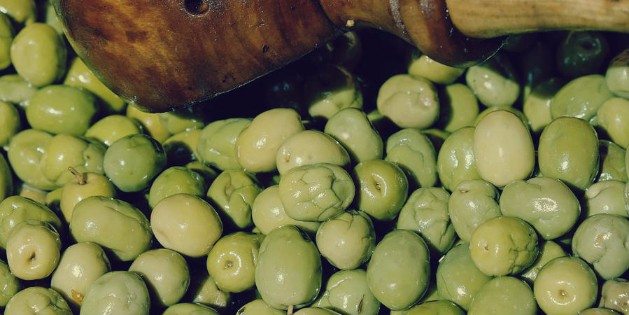
Olives are one of the best vegetables to eat on a keto diet.
Make sure to check out the full guide on olives on a keto diet to learn more about olives, their nutritional value and meal ideas.
Asparagus (One Of The Keto Winners)
Net Carbs: 2 gAsparagus is one of the top and “must-have” vegetables on any low-carb and health-focused diet. Whenever someone is taking about the best foods on keto, the chances are they will list asparagus at the beginning of their list.
This is a really cool vegetable you should eat as much of as you can. It has really few calories (20 kcal) and few carbs (2 g). It tastes awesome with butter, eggs, meat and other most popular keto foods. Both picked and cooked versions of asparagus are very tasty and OK on this plan.
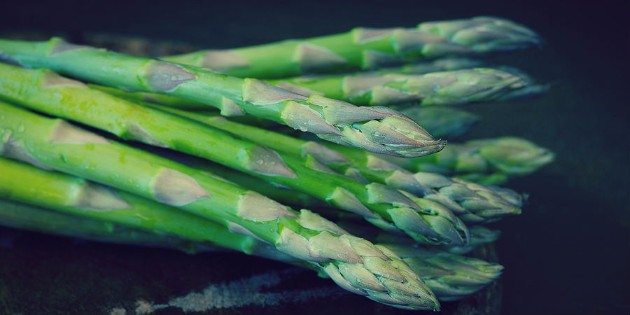
You need to be eating lots of asparagus on keto.
Check out the full guide on eating asparagus on a keto diet to learn more about this great keto vegetable.
Tomatoes (Red And Still OK)
Net Carbs: 3 gWhen it comes to vegetables, a keto diet should be based mostly on green vegetables that grow above the ground. Tomatoes are a small exception and you can eat them rather freely. One or two medium-sized tomatoes a day are OK.
Be careful with dried tomatoes, though. They are way higher in carbs (about 17 g) and very tasty, so it’s really easy to eat a lot of them quickly. I suggest eating only raw tomatoes and rather avoiding tomato sauces or juices (at least in bigger amounts).

Raw tomatoes are OK on a keto diet. Feel free to add them to your salads.
Like eating tomatoes? Don’t miss my guide on eating tomatoes on a ketogenic diet.
Onions (Don’t Be Afraid Of Them)
Net Carbs: 7 gOnions are a bit higher in carbs (7 g) in comparison to most keto vegetables that grow above the ground. However, onions are very healthy and are a great source of copper, vitamin C, potassium, vitamin B6 or vitamin B1. That’s why, you should include them in your salads at least a few times a week.
All you need to do is count their net carb quantity against your daily carb intake you are good to go. Onions are great both raw an cooked (as an addition to your scrambled eggs, for example). You can also even add them to your veggie shakes to improve their taste.

It’s a great idea to add a few slices of onion to your keto salad almost every day.
Learn more about nutritional values of onions and why you should eat them on a ketogenic diet.
Broccoli (Green And Great)
Net Carbs: 4 gBroccoli is one of the top and most often recommended vegetables on a keto diet. You can expect to find it on any ketogenic diet food lists on the Internet and that’s OK. It’s low in calories (only 34 kcal per 100 g) and its net carbs amount only to 4 g. It’s also relatively rich in protein (7 g) as for a vegetable.
There are really tons of ways in which you can eat broccoli and other veggies that perfectly combine with it (for example, avocado). You can eat it both cooked and raw. However, make sure not to overcook it because its glycemic index may rise and spike your insulin.
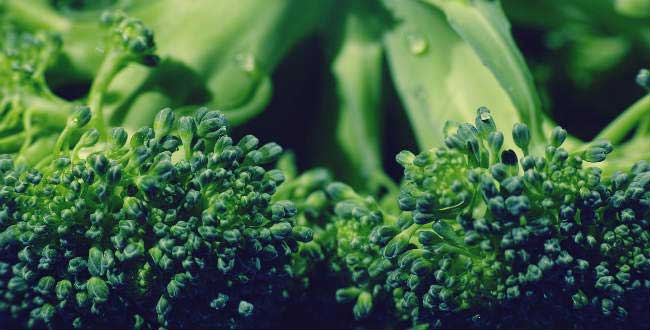
Broccoli is another super keto food you should eat regularly.
Learn more nutritional facts about broccoli and why you should absolutely eat it on a keto diet.
Beans
Net Carbs: about 45 gBeans is best known for being a good source of protein (21 g), potassium (1393 mg) and fiber (16 g). Unfortunately, it also has lots of net carbs, so this is something to rather avoid on a keto diet. Beans is legumes which aren’t the top keto food (even though peanuts are also legumes and are generally recommended on keto).
You can eat it from time to time and in small portions but don’t put it on your everyday keto food list. A good alternative is green beans which has only 4 g of net carbs and is also a relatively good source of potassium (211 mg).
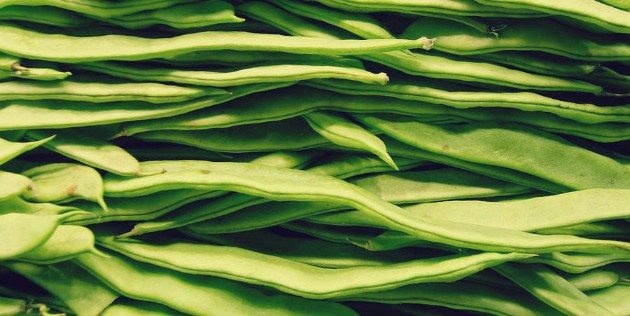
You need to be very careful with eating beans but green beans is relatively OK.
If you want to learn more about beans and eating them on a keto diet (or on any healthy program), check out this article about legumes.
Cucumber (Your Veggie Bread)
Net Carbs: 2 gCucumber is one of the basic vegetables to eat on a keto diet. Not only is it green but it also grows above the ground, which are the two major criteria that usually make a vegetable keto-friendly. yes, cucumbers are really good.
It only has 2 g of net carbs, so you can easily add two or three medium-sized cucumbers to your salad every day. As always, I recommended eating it raw. If you have organic cucumbers, you don’t need to peel them off.
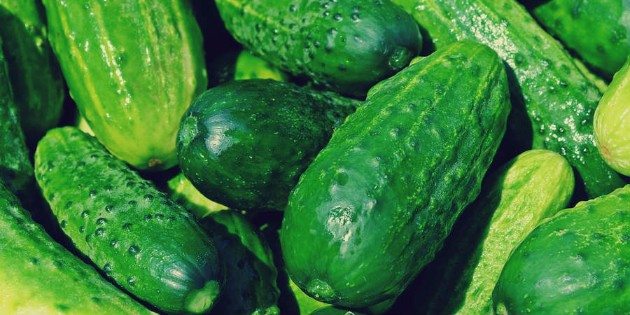
You can eat cucumbers every day on a keto diet.
Check the guide to eating cucumbers on a keto diet to learn more about this basic keto vegetable and its nutritional value.
Carrots (Better Than You Think)
Net Carbs: 7 gEven though they aren’t green and they don’t grow above the ground, carrots are still a very good option on a keto diet. They are very rich in vitamin A (16 00 IU) and potassium (320 mg), so you may want to eat them from time to time.
Of course, I suggest eating raw carrots. You can chop them and add their small amount to almost any dish. One medium-sized carrot has about 4 g of carbs net, so if you want to stay below 20 g of carbs net, count these carbs against your daily intake.

It’s OK to eat small amounts of carrots on a keto diet.
In the guide to eating carrots on a keto diet, you will learn more about their nutritional value and discover other possible ways of adding them to your meals.
Corn (Nope)
Net Carbs: 15 gWhile you can consume small amounts of many not keto-friendly foods, corn is an absolute no-go. Not only is corn high in carbs but it is also genetically modified. What’s more, its glycemic index is relatively high (48), which means it will spike your blood sugar and insulin very easily.
Many people do not even consider it a vegetable (a healthy and nutritious product) any more. And they have a good reason to do that. Fortunately, a ketogenic diet lets you eat tons of other foods so that you can easily find healthy corn alternatives.
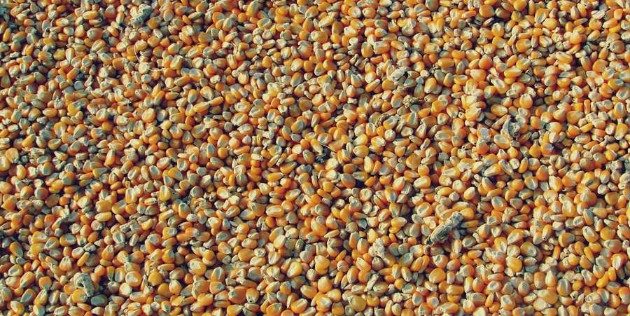
You should avoid eating corn in any form.
I am not particularly interested in corn and studying it in detail (I am interested in all things KETO), so here is an external article about corn in the context of health you might want to take a look at.
Popcorn (No, No, No)
Net Carbs: 60 gI placed popcorn right below corn because this is another absolute “no” on a keto diet. This is simply the worse and more processed version of corn which is not only high in carbs but also has a very high glycemic index (72).
This type of food (or rather the most popular snack in America) will raise your blood sugar and spike your insulin thus stopping any fat burning for a very long time. Avoid it even on your cheat days.

You should avoid both corn and popcorn on this eating program.
I am not planning on creating any special articles or guides on popcorn but if you are interested in it, check this article out.
Beer (Bad News)
Net Carbs: from 5 g up to 20 gBeer is probably the most popular alcohol beverage you will see almost everywhere. Unfortunately, there is a good reason why some people call it “liquid breed”. Of course, not all beers are created equal but you can expect to find as much as 10-15 g of carbs per 100 g of beer, which means that one beer on average can have 50-75 g of carbs. And who drinks just one beer at a party?
If you are just starting out on a keto diet or going through the adaptation period, you should stay away from any alcohol and, especially, beer. However, once you get adapted you might want to look for the few types of beer relatively low in carbs. You can drink these in moderation and occasionally as long as you count them against your daily carb intake.

You need to be very careful with beer on a keto diet.
Check out my guide on beer on keto. You will discover some possible keto beer exceptions and necessary tips on how to drink beer on this eating plan.
Wine (Just Be Careful)
Net Carbs: 2-3 gWhile beer is in most cases a no-go on a keto diet, dry wine (both red and white) is not. We all know about many healthy properties of wine and it’s OK to add some of it to your keto diet.
However, just like with beers, there are different types of wine and not all of them are good for a keto diet. Some sweet or semi-sweet wines can have really a lot of added sugar and will spike your insulin just as much as regular sugary beverages.
However, I can assure you that nothing will happen if you drink a glass (or even two glasses) of dry red or white wine once in a while. Dry wine is very low in carbs and has z zero glycemic index (GI), which makes it totally keto-friendly.

Dry wine in small amounts is OK on a keto diet.
Make sure to read my full guide on drinking wine on a keto diet so that you do it right and don’t let it hinder your progress.
Whiskey (Good Choice)
Net Carbs: 0.1 gIf you want to drink alcohol on a keto diet, whiskey will probably be one of the best choices. It has only 0.1 g carbs and since it’s high in alcohol (it usually has about 40-45% of alcohol), you won’t be able to drink too much of it.
Not a fan of hard alcohol? No problem. You can simply use it as an addition to your softer and equally delicious keto drinks. For example, one of my top keto (but not really healthy) drinks is Zero Coke with a bit of Whiskey (I like to add very little of it so it’s hardly noticeable but still does its job).
Such a drink has very few calories and its alcohol content isn’t huge either, which makes it a perfect drink for a keto cheat day (that happens once in a blue moon).

Whiskey has almost no carbs so it’s OK to have some on a keto diet.
Check out the full guide to drinking whiskey on a keto diet and get more tips for preparing whiskey-based keto drinks.
Vodka (Not A Bad Choice)
Net Carbs: 0 gIf you are to drink alcohol on a keto diet, vodka will probably be the best choice (aassuming you like its taste). It has absolutely no carbs, no fat and no protein. It has some calories (about 230 kcal per 100 g), but due to its high alcohol content you won’t be able to drink a lot of it. That makes it a really keto-friendly drink, especially in comparison to beer which you can easily drink in huge amounts.
If you don’t combine drinking vodka with eating carbs, sugar or a lot of fat. you will be able to get back to ketosis quite quickly (as soon as your liver metabolizes the alcohol contained in vodka you’ve been consuming).
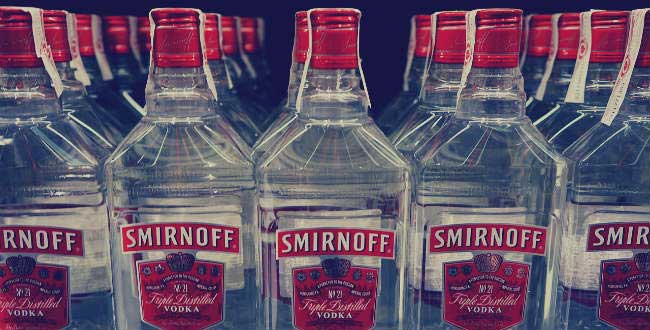
Vodka is probably the best kind of alcohol to drink on a keto diet.
Learn more about drinking vodka on a keto diet and discover tips that will let you stay in ketosis and keep burning fat.
Aspartame (Stay Away From It)
Net Carbs: 0Aspartame is probably the most popular sugar replacement. Unfortunately, this is also the worst choice possible. This is an artificial sweetener which as a characteristic taste. I can immediately tell if it’s in a beverage or not.
This substance, which is a hundred times sweeter than sugar, hasn’t been thoroughly examined yet. Its long-term effect on our body isn’t really known as well. Most “diet” or “zero” drinks like Diet Coke, Pepsi Light or sugar-free Red Bull contain aspartame.
What’s funny is that even some non-diet drinks have aspartame together with sugar. That’s because aspartame is cheaper than sugar.The best piece of advice here is to stay away from aspartame and use natural sugar replacements like Stevia or erythritol.
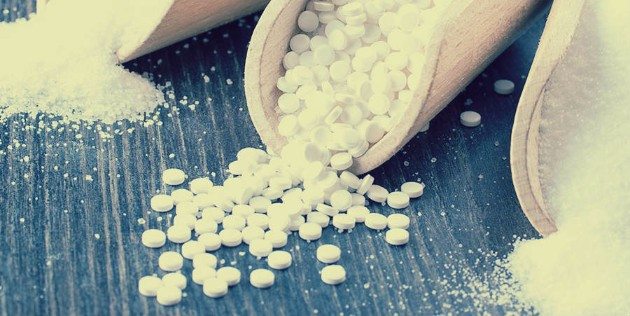
Replacing sugar with artificial aspartame isn’t the best idea.
Learn more about aspartame, its properties and nutritional value in the guide to eating aspartame on keto. Check the article on aspartame on Wikipedia.
Splenda
Net Carbs: 90 gSplenda is simply a bit different kind of sugar that has recently been used as sugar replacement. This is in fact the commercial name for an artificial sweetener called sucralose. There is no doubt that it’s better when compared to pure sugar and if you have to choose between the two I recommend Splenda.
However, when it comes to its keto-friendlines, Splenda isn’t the best choice. Not only does it have quite many calories (331 kcal per 100g) but it also spikes insulin. It’s only a bit better version of sugar and should be treated as such.

It’s best to use Stevia or erythritol instead of Splenda on a carb-restricted diet.
Learn more about Splenda and why you should avoid this particular sweetener on a keto diet. Or check the article about Splenda on Wikipedia.
Stevia (Should Become Your Best Friend Too)
Net Carbs: 5gWhat makes Stevia (together with the below erythritol) the best sweetener in the world is the fact that it has almost no carbs (5 g per 100 g) and its glycemic index (GI) is 0. What’s more, it’s natural and haven’t been found to cause any side effects.
If you absolutely cannot live without the sweet taste (just like me), make sure to replace sugar and any artificial sweeteners with stevia. It’s available in tabs, as powder and in the liquid form. It’s sweeter than sugar and has a stronger taste but you will get used to it and like it.

Even though Stevia is keto-friendly, I recommend not using it more often than once a day (in your keto coffee or tea).
Learn more about stevia and how you can make best use of it on a keto diet. Or check the Wikipedia article describing stevia in more detail.
Erythritol (Fall In Love With It)
Net Carbs: 5 gErythritol is (together with Stevia) one of the best sugar replacements you can think of on a keto diet. It has only 5 g of carbs in 100 g and has a glycemic index (GI) of 0, which makes it a totally keto-friendly product. You can have it in the granular and powdered form.
It has a bit different taste than Stevia and is a bit less sweet, so it’s ultimately up to you which one you decide to choose. It causes much less negative effects (like gas or bloating) when compared to other sugar alcohols and is for the most part excreted unchanged with urine.
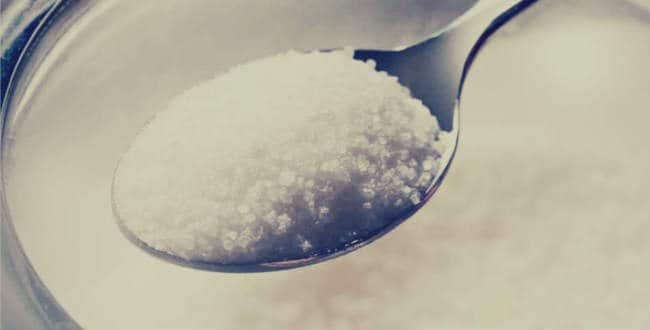
Erythritol is one of top natural sweeteners on a keto diet.
Learn more about erythritol and how you can make best use of it on a keto diet. You can also browse the whole guide to keto sweeteners and choose the best one for you. Or check the article about erythritol on Wikipedia.
Maltitol
Net Carbs: 67Maltitol is one of the biggest “keto lies” you need to be aware of. There are really tons of sugar-free products that are sweetened with maltitol.
These products shouldn’t be marked as sugar-free because maltitol has carbs (67 g) and, what’s worse, has a glycemic index of 36. When compared to sugar it’s a bit better, but if we are looking for keto-friendly products, maltitol shouldn’t be on this list.

Beware of sugar-free chocolate that’s sweetened with maltitol. It’s not really that keto-friendly.
Learn more about eating maltitol on a keto diet in this special guide. Or check the Wikipedia article about maltitol.
Xylitol
Net Carbs: 60 gWhat makes xylitol a relatively good option is the fact that it’s not an artificial sweetener. However, it’s not the best option on a keto diet because it has some carbs (60 g), some calories (240 kcal) and its glycemic index is of 13.
What it means is that it’s not entirely indifferent to our digestive system. Of course, it’s way better than sugar or artificial aspartame but you need to keep in mind that it’s not calorie or carb free. If you want to use it, you need to count it against your daily carb intake.

Be careful with xylitol because it can still spike insulin a little bit.
Learn more about xylitol and how to eat it on a keto diet in this special guide. Or view the Wikipedia article on xylitol.
Congratulations (I Mean It)
If you reached the end of this very long page, you are really up for a good start and on your way to success. You have read almost 12000 words. Congratulations!
More Keto Diet Resources (You Need To Go Further)
Knowledge is power and key to your success. Take a look at other in-depth keto diet tutorials available here on ABC Keto.
- About Keto Diet to master the basics and get a head start on a keto diet
- Keto Recipes to start cooking the healthiest and the most tasty meals on earth
- Keto Diet And Weight Loss to get inspired and effortlessly lose weight
- Intermittent Fasting to discover a secret weight loss and health tool our ancestors used
Help ABC Keto Improve
Do you want me to add more information about a specific type of food? Do you want discover even more keto foods? Have you noticed a mistake on this web page? Is some part of this section not entirely clear? Let me know!
This section (and the whole ABC Keto) has been created for you and its purpose is to serve you. That’s why I want you to help me make my website as cool as possible.
Feel free to leave your suggestions. You can either leave me your comments or contact me directly. I would love to hear from you.


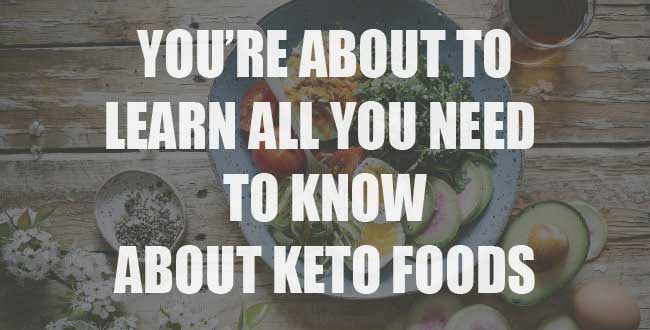
 Common Product Concerns On Keto… Don’t Miss This
Common Product Concerns On Keto… Don’t Miss This